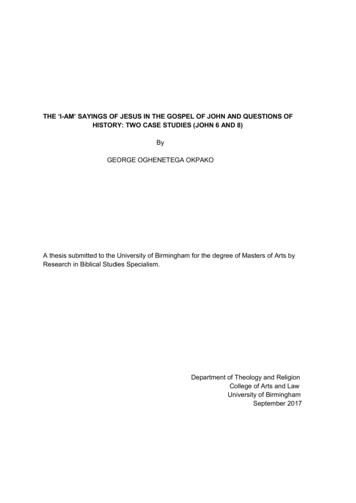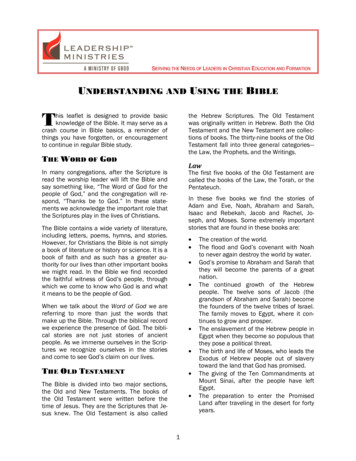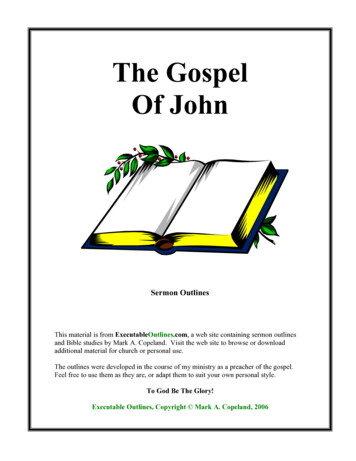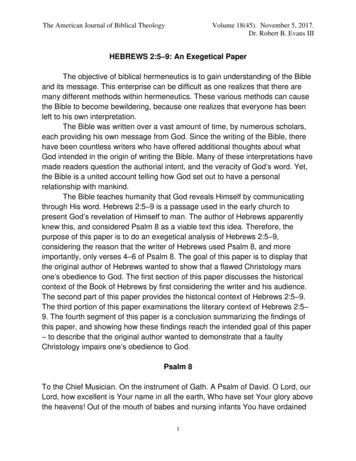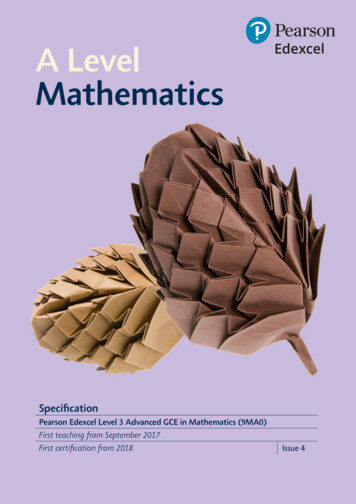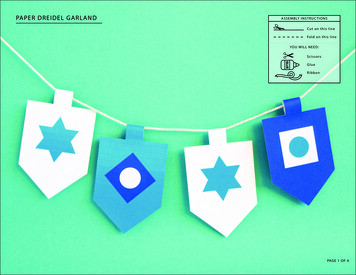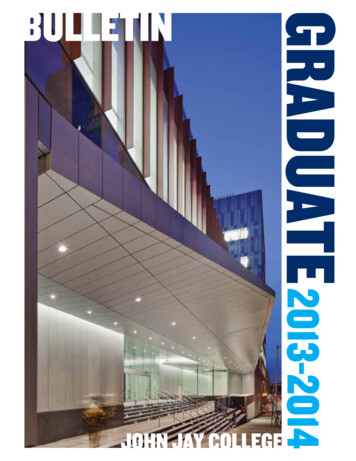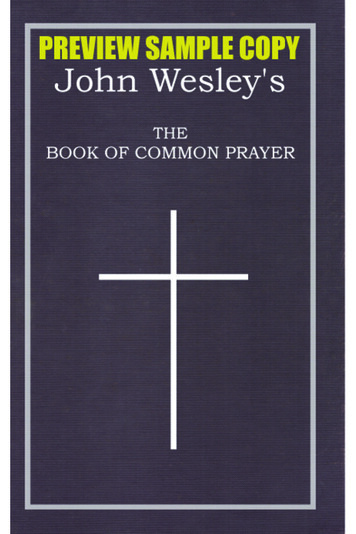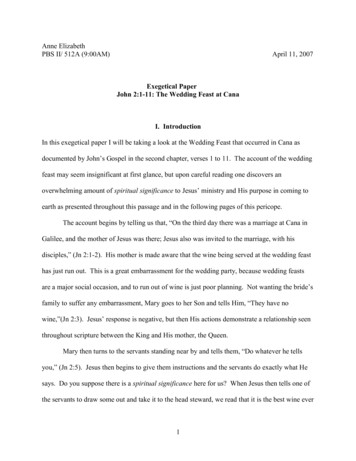
Transcription
Anne ElizabethPBS II/ 512A (9:00AM)April 11, 2007Exegetical PaperJohn 2:1-11: The Wedding Feast at CanaI. IntroductionIn this exegetical paper I will be taking a look at the Wedding Feast that occurred in Cana asdocumented by John’s Gospel in the second chapter, verses 1 to 11. The account of the weddingfeast may seem insignificant at first glance, but upon careful reading one discovers anoverwhelming amount of spiritual significance to Jesus’ ministry and His purpose in coming toearth as presented throughout this passage and in the following pages of this pericope.The account begins by telling us that, “On the third day there was a marriage at Cana inGalilee, and the mother of Jesus was there; Jesus also was invited to the marriage, with hisdisciples,” (Jn 2:1-2). His mother is made aware that the wine being served at the wedding feasthas just run out. This is a great embarrassment for the wedding party, because wedding feastsare a major social occasion, and to run out of wine is just poor planning. Not wanting the bride’sfamily to suffer any embarrassment, Mary goes to her Son and tells Him, “They have nowine,”(Jn 2:3). Jesus’ response is negative, but then His actions demonstrate a relationship seenthroughout scripture between the King and His mother, the Queen.Mary then turns to the servants standing near by and tells them, “Do whatever he tellsyou,” (Jn 2:5). Jesus then begins to give them instructions and the servants do exactly what Hesays. Do you suppose there is a spiritual significance here for us? When Jesus then tells one ofthe servants to draw some out and take it to the head steward, we read that it is the best wine ever1
tasted, and instead of being embarrassed, the groom is now praised, thus also the bride’s familyshares in that praise. What is significant about the wine and the fact it was the best ever tasted?What is the spiritual significance to Jesus choosing a wedding feast as a location for Hisfirst public miracle? Is there any significance to the jars He used or the amount of water that wasin them? Is it possible that there is more to this story than meets the eye? I suggest the answer is,“Yes”.2
II. Historical AnalysisThe cultural and historical significance of the Wedding Feast at Cana involves threedifferent aspects. The first aspect is the day on which the feast is celebrated and its importance.The second aspect involves the traditions surrounding a Jewish marriage feast and how Jesus’involvement in this type of feast is intimately connected with His kingdom. The third aspectinvolves the vessels used in a wedding feast and the significant role they played in Jesus’ firstpublic miracle.The first aspect involves the day on which the celebration of this wedding took place.We know from earlier accounts found in John1:35-49, that just before the wedding feast on dayone, Jesus travels throughout the region gathering Andrew, John, Peter, James, and then on daytwo Philip and Nathaniel. It is in the following chapter that John then tells us, “On the third daythere was a marriage at Cana in Galilee,” (John 2:1), and that Jesus and His mother was therealong with Jesus’ disciples (ref John2:2).On a brief side note, scholars have long since speculated why Jesus was able to bring newpeople to a wedding feast that undoubtedly required an invitation. William Hendriksen gives thefollowing two possibilities. As the distance between Cana and Nazareth are not too far apart,thus the distance Jesus had to travel would not be too great or too out of His way. Upon arrivingin Nazareth, He would have received the invitation notice from His mother, and that invitationwould most likely include “all who were with [H]im”. The second possibility Hendriksen listsinvolves Nathaniel, who was from Cana, probably knew the bridegroom or as, “Some are of theopinion that he was a relative of the bridegroom,” would have been authorized to extend3
invitations to his own close friends with the blessing of the bridegroom. For such was the customin those days.”1 To return to what day the wedding feast was celebrated.This third day’s significance reflects three things. First, on the third day of creation,“God pronounced things “good” twice Therefore to the Jewish people, the third 3rd day isknown as a day of double blessing, and is still the preferred day for weddings in modern Israel.2Stephan K. Ray notes in his commentary, “It may, in fact, refer to the beginning of a newcreation, a new week of creation.”3 When a man and woman join their lives in marriage, theyare becoming that new creation, they are becoming one flesh (ref Gen 2:24).Secondly, the tradition of a Jewish wedding feast involves seven days of celebration (refTobit 11:19), and usually, as Stephen K. Ray notes, takes place at the bridegrooms house andincludes many close relatives and friends4. Ray also notes in the same paragraph that the HeadSteward, who in John’s Gospel receives the first taste of the miraculous wine, is usually also aclose friend. This gives rise to Mary’s role in telling Jesus that the wine had run out. Both Rayand Hendrickson believe that Mary was in fact a close friend or relative to the family of thewedding party. Thus she would have been involved in the preparation of the food and drink.Also in Jewish circles, both today and yesterday, the use of wine is quite significant. Stephen K.Ray notes this in particular when he speaks of the Aramaic meaning, mistita, or drink festival,“ with which accords the rabbinical dictum: ‘Where there is no wine, there is no joy’ The1William, Hendriksen. New Testament Commentary: Exposition of the Gospel According to John. (Grand Rapids:Baler Book House,1967), 114.2“Water into Wine”, Children’s Stories for Adults; er-into-wine;Found 2/8/20073Stephen K. Ray, St. John’s Gospel: A Bible Study Guide and Commentary for Individuals and Groups (SanFrancisco: Ignatius Press, 2002), 72.4Ibid., 74.4
lack of wine was not only an embarrassment for the bridegroom, but also a disruption of thefeast, and it rendered the family open to a lawsuit.”5The intimate connection comes when Jesus is referred to by John the Baptist as the“bridegroom” (Jn 4:30) and later when, Jesus uses wine to establish the New Covenant. Just asat the wedding feast in Cana when Jesus provides and abundance of new wine, so to will He giveof Himself, body-blood-soul-and divinity, for the salvation of many in the forms of bread andwine.The last aspect involves the vessels used in Jewish wedding feasts, and in particular thejugs of water used for purification (see Numbers 19:11-22). The text tells us, “Now six stonejars were standing there, for the Jewish rites of purification, each holding twenty or thirtygallons, (John 2:6). That is a lot of water if one does the math. There are six stone jars, eachable to hold 20 to 30 gallons of water – 30 gallons X 6 180 gallons of water! The historicalsignificance demonstrates that there are a large number of guests attending the wedding if 180gallons of water is used to purify them upon entering the feast, as was custom6. This numberwill also serve later as the sign of Jesus’ gift and His abounding Love for mankind. As StephenK. Ray notes, “The water in the jars, used for Jewish purification rituals, will be transformed intoa ‘sign’ in and through which the doxa [glory] will be revealed.”7 Purification began on theoutside for the Jews, but soon that purification will be brought inside, to the heart and soul of aperson. The stone jars will soon become clay vessels who will receive a ‘new wine’ in them, aswe also become new vessels made for a new covenant, and thus are made into a new creation asmentioned in the first aspect.5Ibid., 76.“Water into Wine”, Children’s Stories for Adults; er-into-wine;Found 2/8/20077Stephen K. Ray. St. John’s Gospel: A Bible Study Guide and Commentary for Individuals and Groups. (SanFrancisco: Ignatius Press, 2002), 82.65
Thus these three aspects play a very important role in the establishing of the historicalcontext in which Jesus’ first public miracle, His first gift of love, is given to us. With this event,we begin a journey of faith into Jesus, the Christ, starting in Cana with His first public miracle.6
III. Grammatical AnalysisJohn’s use of language is, I believe, a bit more significant than the synoptic Gospel writers inthat his Gospel account focuses so much more on the spiritual significance of events rather thanjust recounting the historical significance. Yet, John’s presentation of the Wedding Feast(Syntactical) is very systematically laid out. There is a clear sense of time and the order of theevents follow each other smoothly. While John’s use of several Semitic Idioms (Lexical) like“woman” – when Jesus refers to His mother, Mary – help the reader to better appreciate thelanguage used at the time of Christ, and gives the reader a better understanding of the spiritualsignificance of this passage.A. Syntactical: John begins by telling us it was the third day and there was a weddingfeast (ref Jn 2:1). He then gives the reader a glimpse into the wedding feast telling us that Jesuswas there with His first disciples and His mother, Mary, was there too, (ref Jn2:2,1). Mary issomehow connect with the organization of the feast because she notices when they run out ofwine and tells her Son, “They have no more wine,” (Jn 2:3). John tells us Jesus responds, andnot too favorably, but Mary still turns to the servants and tells them, “Do whatever he tells you,”(Jn 2:5). By reading that, we see how systematically John wrote down the facts. This happenedand then this happened. This was the day of the wedding feast, and here are some of the guestswho were invited. John is very clear cut as to the details. He continues to tell us that Jesus gavea few simple instructions to the servants and the servants followed His instructions to the letter.When the water is drawn out and given to the head steward, most likely in a cup, it is here thatwe find out what extraordinary event has just taken place. Still, John does not embellish thefacts, he just clearly states what happened. The head steward tastes the wine and calls over thebridegroom to compliment him on his choice of saving the good wine for last, (ref Jn 2:9-10).7
As a result, Jesus’ disciples believe in Him, (ref Jn 2:11). It is in the use of the common dayHebrew Idioms that John begins to express the spiritual significance of the whole event.B. Lexical: First, the use of the word, “woman”, which many misguided souls hadthought rude and inconsiderate of Christ, is in reality a sign of deep respect that will reappearlater in John’s Gospel, (see Jn 19:26-27). Stephen Ray offers some insight into the word and itsusage during the time of Christ when he states, “To understand Jesus’ manner of addressing hisMother, we must take into account the idioms of the Semitic languages,” (Ray, St. John’sGospel, 78). Woman is literally to be translated as “Lady” and was commonly used during thetime of Jesus8. Its use was one of great respect and politeness9 that, “On the Cross Jesus willuse with great affection and veneration,” (Ibid.,78). Another use of an idiom occurs whenJesus responds with, “ what have you to do with me, 10” (Jn 2:4). This literally translates fromits idiomatic use as, “What to me and thee?”11 This is another example of Jesus’ respect for Hismother. As St. Peter Chrysologus, Archbishop of Ravenna states, “That He greatly veneratedHis mother, we know from St. Luke, who tells us that He was subject unto His parents,”12Therefore, this particular idiom demonstrates “ the free consent of one party to the expressedwill of another since Jesus promptly complies with Mary’s request (2:7-8) and Mary neverwavers in her confidence that Jesus will respond favorably to her petition (2:5),”13. The spiritualsignificance is made very clear in the duty and honor Mary holds with her Son.8“ this was a title of respect and endearment in antiquity.” Hahn, Scott., Mitch, Curtis., Walters, Dennis. TheGospel of John(San Francisco: Ignatius Press, 2003), 20 (2:4 footnotes).9“Jesus’ mode of addressing her [as] Woman may sound harsh, but in its time it was polite and respectful,” Brodie,Thomas L. The Gospel According to John: A Literary and Theological Commentary. (New York/Oxford: OxfordUniversity Press, 1993), 174.10“And when he says to her ti emoi kai soi, literally “What [is there] to me and to you?””(Ibid., 174).11Stephen K. Ray. St. John’s Gospel: A Bible Study Guide and Commentary for Individuals and Groups. (SanFrancisco: Ignatius Press, 2002), 7912Harmony Media. Biblical Commentary on the Gospel of John chapter2.CDROM. 2003.13Hahn, Scott., Mitch, Curtis., Walters, Dennis. The Gospel of John(San Francisco: Ignatius Press, 2003), 20 (2:4footnotes).8
The final words of this passage, “My hour has not yet come,” (Jn 2:4), also suggestssomething more important, some sort of spiritual significance beyond an ordinary hour,indicating that Jesus is conscious of the fact, “ that he was accomplishing a task entrusted tohim by the Father, every detail of which had been definitely marked off in the eternal decree, sothat for each act there was a stipulated moment,”14 This statement is further supported in John5:19, where Jesus tells the Jews He can do nothing apart from the Father, and is thus a significantreminder to us that, we too, can also do nothing apart from Him. Thus Jesus waits a momentmore for the appointed time of His first miracle, one that will not, “ by any independent orpremature action appear to be seeking his own glory ”15 but will demonstrate the Glory of HisFather in Heaven who has given the Son an example to imitate (ref John 5:19-21), that will bringabout the Glory of His Son when God raises Him on the third day.14William, Hendriksen. New Testament Commentary: Exposition of the Gospel According to John. (Grand Rapids:Baler Book House,1967),115.15J.N. Sanders. B.A. Mastin, ed., A Commentary on the Gospel According to St. John. (New York: Harper & Row,1968), 110.9
IV. Rhetorical AnalysisThe genre and structure of John’s Gospel is also quite unique just as his use of grammar.The genre is not allegorical or poetical, instead John lays out the events in an orderly fashion,relating them as they happened, with no embellishment, no ‘thunder-claps’, just simply statingthe facts. This makes the genre of John’s account of the Wedding Feast at Cana, Historical. Thesignificance of these events is made clear by the chosen literary devices and structure used byJohn. In particular is his use of chiasm to emphasize the spiritual significance of the historicalevents. We begin with the genre.The recounting of historical events as they happened tells us the type of genre John choseto use, historical. At yet, John adds a deeper understanding to these events, and as Stephen K.Ray notes, “John does not give us “parables” in the strict sense instead he recounts numeroushistorical stories in such a way that they serve as parables by inviting us to discover deepspiritual truth.”16 Which is the running theme established in the Historical and Grammarsections; John speaks of events in light of their spiritual significance. This is made even moreobvious when we take a look at the structure of this passage.John helps us to focus on the spiritual with the way he structures this passage. Itis a form of inclusion alluded to in Ray’s book called chiasm17, “ [it is used] in order toemphasize and frame the events and truths [found in] parallel phrases escalating to a middletheme [for further] emphasi[is].”18 He sites some examples of this use of inclusion by pointingout the way John makes obvious Mary’s importance in her Son’s ministry. Mary is present at16Stephen K. Ray. St. John’s Gospel: A Bible Study Guide and Commentary for Individuals and Groups. (SanFrancisco: Ignatius Press, 2002), 72.17“Chiasm is a development of inclusion.[and] extends the balancing of the first and the last by balancing thesecond and the fourth [thus a-b-c-b-a] It is used by John, [and] is the key to the structure of his Gospel as awhole, and to the structure of each individual sequence and section.” Ray, St. John’s Gospel: A Bible Study Guideand Commentary for Individuals and Groups. (San Francisco: Ignatius Press, 2002), 72 (footnote 1).18Stephen K. Ray. St. John’s Gospel: A Bible Study Guide and Commentary for Individuals and Groups. (SanFrancisco: Ignatius Press, 2002), 72.10
Jesus’ first public miracle and she is present at His last saving act, His death on the Cross. Herbeing present at these two events gives rise to Mary’s presence as vital to Jesus. How else couldHis disciples develop the love necessary for the woman who was to become the Mother of theChurch? In further retrospect, how are we, in today’s Church, to know the significance of theMother of Christ had it not been made manifest in the scriptures? None of the other Gospelwriters give such an account, even though Luke’s Gospel does site the Annunciation and theNativity of Jesus, he does not mention Mary again. John’s Gospel is unique in this style ofwriting. It is a result of this use of inclusion that we, and all who read John’s account, can cometo understand the important spiritual significance of the events beyond their historical accounts.This style of inclusion occurs again when Mary is linked directly with the disciples ofJesus, as noted by Brodie. He states, “The opening verses (1:1-2) contain two phrases which linkJesus first with his mother and then with his disciples The literary structure in these verses issuch that it suggests a balance between the ‘mother’ and ‘his disciples’ [as the scene] beginswith the mother of Jesus (2:1) and ends with ‘his disciples’ (2:11).”19 Thus the disciples’presence at Jesus’ first miracle and the involvement of His mother connects the reader tounderstand that both she and them are absolutely necessary for instructing us in the fullsignificance of Jesus’ gift of changing the water into wine.The use of literary indicators are noted by Brodie as, “ specific details with suggest atransition from one scene or part to the next.”20 This is accomplished by the repeating of theword, “there” – Greek translation “ēsan de ekei”21. It occurs twice, once at the beginning ofverse 6 when referring to the water pitchers, and then again when referring to the Mother of19Thomas L. Brodie. The Gospel According to John: A Literary and Theological Commentary. (New York/Oxford:Oxford University Press, 1993), 174-175.20Ibid., 171.21Ibid., 171.11
Jesus at the end of verse 1, “The use of so small a word as ekie, “there”, may at first seeminsignificant.[but] its sudden repetition when preceded by the verb to be, acts as an initialindicator that perhaps the scene should be divided accordingly.”22 Giving the reader a sense thata mystery is about to be revealed, the mystery concerning Christ’s love for us. Especially whenit is brought to fulfillment at the Eucharist and then at the Cross.As pointed out by Hendriksen, “In thorough keeping with this fact is the followingclause: and manifested his glory. Christ stands revealed as One whohonors marriage Christ is himself the Bridegroom One who bestows his gifts lavishly allhis gifs are the very best One whose infinite love is made effective by his infinitepower One who is the Son of God full of grace and glory And his disciples believed inhim [their belief] strengthened by this sign23,” allows the reader to understand the truesignificance of Jesus’ miracle, how it is intimately connect to the Kingdom of Heaven, remindingus we are the Bride and He is the Bridegroom and, “there is created a sense of waiting andexpectation24,” as the Old Covenant passes away and the New Covenant begins in Jesus Christ.This is the spiritual significance of the sign Jesus performed at the wedding in Cana.22Thomas L. Brodie. The Gospel According to John: A Literary and Theological Commentary. (New York/Oxford:Oxford University Press, 1993), 171.23William, Hendriksen. New Testament Commentary: Exposition of the Gospel According to John. (Grand Rapids:Baler Book House,1967), 118.24Thomas L. Brodie. The Gospel According to John: A Literary and Theological Commentary. (New York/Oxford:Oxford University Press, 1993), 172.12
V. Canonical AnalysisThe two steps of analysis that I chose to focus on for this section of this paper are: One,on how this text relates to other material found within the Gospel of John, and: Two, what themeis found throughout of John’s Gospel that begins within this account.As already alluded to in the prior sections, John’s Gospel focus concentrates on thespiritual significance of the events that occur. Occur to whom? Occur to Jesus, the Son ofMary, but also the Son of God. When Jesus turns the water into wine at the wedding feast inCana, He says something about Himself in and thru the use of a sign. As Hendriksen points out,“[This] term is used more often by John than by the other Gospel-writers. It indicates a miracleviewed as a proof of divine authority and majesty ,”25 which is again addressed with John’saccount of the Last Supper when Jesus will once again use wine as a symbol, but this time as Hisown blood26.As Hendriksen defines what a sign is, he states, “ the sign points away from itself to theOne who performs it a work of power in the physical realm, illustrates a principle that isoperative in the spiritual realm which takes place in the sphere of creation [and] points awayfrom itself to the sphere of redemption.” 27 The multiplication of loaves that take place with thefeeding of the multitudes, the opening of the blind man’s eyes, the raising of Lazarus, they areother examples of a sign that points to Jesus and gives testimony of His authority over all things.As John the Baptist declared to his disciples, “Behold the Lamb of God!” (John 1:29). Brodielends support to Hendriksen’s understanding of sign by stating, “A sēmeion [Greek sign] is anysignificant action the fact that the gospel refers to the Cana incident as a sign indicates that it25William, Hendriksen. New Testament Commentary: Exposition of the Gospel According to John. (Grand Rapids:Baler Book House,1967), 117.26Ref - Scott Hahn et al., The Gospel of John. (San Francisco: Ignatius Press, 2003), 20 (footnote2:10, no. 3).27William, Hendriksen. New Testament Commentary: Exposition of the Gospel According to John. (Grand Rapids:Baler Book House,1967), 117.13
is the meaning that is really important.”28 This brings us to two very important themes found inthe Gospel of John and connects directly to the whole of scripture, obedience and service.God works His miracles through His instruments. This occurs repeatedly throughout theOT accounts beginning with Moses, who lead the Israelites out of Egypt (see Ex 13), followedby the prophets, all of them preached when God asked and many were killed for their preaching,then on to King David, who brought the tabernacle back to Jerusalem, and his son Solomon, whobuilt the Temple as the dwelling place for the Lord and that tabernacle. Coming to completionwith the birth of God’s only begotten Son who was obedient unto death, even death on a cross(ref Phil 2:8). Jesus, too, works His miracles with the help of others. None so obvious as whenHe turned water into wine. How was Jesus able to accomplish this? By the intercession of Hismother, Mary, who told the servants, “Do whatever He tells you,” (John 2:5), Jesus begins. Theservants then follow thru by doing what Jesus tells them to do. He says, “Fill the jars withwater." And they filled them up to the brim. (John 2:7), then He tells them, "Now draw someout, and take it to the steward of the feast." So they took it. (John 2:8). They followed Jesus’instructions to the letter, “Thus the miracle is not in any juggling which Jesus does with thewater, but in the acceptance of his word by the servants.”29 This theme of obedience to the wordsof Jesus will continue throughout John’s Gospel with His disciples also listening and then doingwhat He tells them to do.Thus service also becomes a theme in John’s Gospel and will continue to reappear.Jesus reminds His disciples at the Last Supper in chapter 23, verses 12 thru 19, of the importanceof serving one another, and those who later will be entrusted to their care, by following His ownexample. Brodie offers this final piece of insight, “ the idea of revelation, of the fact that at28Ibid., 173.Thomas L. Brodie. The Gospel According to John: A Literary and Theological Commentary. (New York/Oxford:Oxford University Press, 1993), 173.2914
Cana Christ’s power brings into the world a manifestation of glory it is though and in theattentive servants and disciples that the miracles happen through their grasping of his word andof its meaning through their response – that the revelation is fulfilled ”30 With obedience andservice to God’s perfect Will, we too can experience the miracles of Jesus. As John’s Gospeldemonstrates, great things happen when God works through us and with us when we become Hisobedient servants listening to His Word.30Thomas L. Brodie. The Gospel According to John: A Literary and Theological Commentary. (New York/Oxford:Oxford University Press, 1993), 171-72.15
VI. Liturgical AnalysisAfter an extensive search, the only reference to the Wedding Feast at Cana was found in theliturgical cycle of readings for Year C, the second Sunday of Ordinary Time. Along with thisreading is a reading from Is 62:1-5, and 1 Cor 12:4-11. Having examined each, I only findreference to marriage in Isaiah, and only towards the end.Isaiah reads, “4 You shall no more be termed Forsaken, and your land shall no more betermed Desolate; but you shall be called My delight is in her, and your land Married; for theLORD delights in you, and your land shall be married. 5 For as a young man marries a virgin, soshall your sons marry you, and as the bridegroom rejoices over the bride, so shall your Godrejoice over you [emphasis mine]”. Jesus is the fulfillment of this promise. He is thebridegroom and His church becomes the bride. He rejoices in us and gives us an abundance ofgifts.This is where 2Corinthians comes in. It reads, “Now there are varieties of gifts, but thesame Spirit; 5 and there are varieties of service, but the same Lord; ” embracing John’s use ofthe stress of service being part of the kingdom of heaven (refer back to Canonical Section), “7 Toeach is given the manifestation of the Spirit for the common good 11 All these are inspired byone and the same Spirit, who apportions to each one individually as he wills,” Paul tells thechurch at Corinth that Christ gives generously to His bride, that is us, the Church. John stressesthis also in his passage when he tells us that the wine Jesus made was of the finest quality, thusthe guests at this wedding feast enjoyed the Bridegroom’s generosity, even though they did notknow where the wine had come from.16
VII. Magisterial AnalysisOn the Magisterial side, the Wedding Feast at Cana emphasizes the dogmatic truth that Mary isthe Mother of God or Theotokos (Greek). As the Mother of God, she also becomes the mainintercessor or mediatrix31 for all of mankind with her divine Son. This places on Mary duerespect and honor as demonstrated by her Son (ref John 2:7-11), and thus calls us also to payMary the greatest honor one can for another creature, for she is favored by God (ref Luke 1:28).Back in AD 431, a council was called in Ephesus to address the motherhood of Mary.This motherhood would not just reflect on her, but also on her Son. If Jesus was indeed theWord made flesh, the only begotten Son of God, then Mary had to be the Mother of God. Theresult of the proceedings of the council was two fold. One, “Mary is truly a mother, that is, shecontributed everything to be formation of the human nature of Christ that every other mothercontributes to the formation of the fruit of her body.”32 The passage clearly states, “On the thirdday there was a marriage at Cana in Galilee, and the mother of Jesus was there [emphasismine];” (John 2:1), thus Mary is the mother of Jesus. Two, “Mary is truly the Mother of God,that is, she conceived and bore the Second Person of the Divinity, not indeed according to theDivine Nature, but according to the assumed human nature.”33 Jesus’ first public miracle givesbeginning proof that He is the Messiah, the one prophesized to come, and yet because He wasborn of Mary, a human creature, so He is also a man; which tells us that Jesus, being man, alsohas all things human including a human nature.31"This motherhood of Mary in the order of grace continues uninterruptedly from the consent which she loyallygave at the Annunciation and which she sustained without wavering beneath the cross, until the eternal fulfillment ofall the elect. Taken up to heaven she did not lay aside this saving office but by her manifold intercession continuesto bring us the gifts of eternal salvation. . . . Therefore the Blessed Virgin is invoked in the Church under the titles ofAdvocate, Helper, Benefactress, and Mediatrix." CCC 969.32Ludwig Ott. Fundamentals of Catholic Dogma. (ed. J.C. Bastible, D.D.; trans. P. Lynch, Ph.D.; Illinois:Tan,1960), 196.33Ibid.17
Mary, as His mother, plays a role in this first miracle, for as the late John Paul II tells us,“The mother of Christ presents herself as the spokeswoman of her Son’s will her faith evokeshis first ‘sign’ and helps to kindle the faith of the disciples.”34 John Paul II, no doubt, knewpersonally Mary’s role within her Son’s mission of salvation as he had a great devotion to theMother of Our Lord. After all, he was “Peter” the Vicar of Christ’s Church. Continuing inMother of the Redeemer, John Paul II comments, “In John’s text the description of the Canaevent outlines what is actually manifested as a new kind of motherhood according to the spiritan
III. Grammatical Analysis John’s use of language is, I believe, a bit more significant than the synoptic Gospel writers in that his Gospel account focuses so much more on the spiritual significance of events rather than just recounting the historical significance. Yet,
